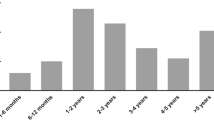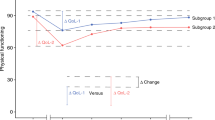Abstract
Objective
To explore whether determinants of global quality of life (QOL) change before and after major cancer surgery.
Methods
Consecutive patients (n = 145) undergoing surgery for upper gastrointestinal cancer were prospectively studied and asked to complete the EORTC QLQ-C30 before and after 6 months. Excluded were patients found to be inoperable (n = 12) and those with missing second questionnaires (because of death n = 20, poor health (n = 10), administrative failure (n = 7) or patient refusal (n = 4)). Multivariable linear regression models investigated associations between global QOL and other scales and items of QOL adjusting for clinical variables.
Results
Some 87 patients completed both questionnaires. Before surgery the main predictors of global QOL were physical and emotional function, with adjusted increases in global QOL of 0.55 (95% CI 0.26–0.84; P < 0.001) and 0.30 (95% CI 0.14–0.45; P < 0.001) per unit increase of physical and emotional function, respectively. Six months after surgery, however, fatigue and dyspnea most strongly predicted global QOL, with adjusted differences in global QOL of −0.24 (95% CI −0.44 to −0.04; P = 0.02) per unit increase of fatigue and −6.28 (95% CI −12.64 to 0.07; P = 0.05) for those experiencing any symptoms of dyspnea.
Conclusion
Further work is needed to test these findings, but the results suggest that the global QOL scale in the QLQ-C30 is difficult to interpret and it should be considered within the context of other clinical and patient reported outcomes.

Similar content being viewed by others
Abbreviations
- PRO:
-
Patient-reported outcome
- QOL:
-
Quality of life
- CI:
-
Confidence interval
- EORTC:
-
European Organization for Research and Treatment of Cancer
- IQR:
-
Interquartile range
References
Food and Drug Administration. Patient-reported outcome measures: Use in medical product development to support labeling claims. DRAFT GUIDANCE. http://www.fda.gov/cder/guidance/5460dft.pdf. Accessed July 12, 2008.
Goodwin, P. J., Black, J. T., Bordeleau, L. J., & Ganz, P. A. (2003). Health-related quality-of-life measurement in randomized clinical trials in breast cancer-taking stock. Journal of the National Cancer Institute, 95, 263–281.
Blazeby, J. M., Avery, K., Sprangers, M., Pikhart, H., Fayers, P., & Donovan, J. (2006). Health-related quality of life measurement in randomized clinical trials in surgical oncology. Journal of Clinical Oncology, 24, 3178–3186.
Bottomley, A., Efficace, F., Thomas, R., Vanvoorden, V., & Ahmedzai, S. H. (2003). Health-related quality of life in non-small-cell lung cancer: Methodologic issues in randomized controlled trials. Journal of Clinical Oncology, 21, 2982–2992.
Efficace, F., Kemmler, G., Vignetti, M., Mandelli, F., Molica, S., & Holzner, B. (2008). Health-related quality of life assessment and reported outcomes in leukaemia randomised controlled trials—a systematic review to evaluate the added value in supporting clinical decision making. European Journal of Cancer, 44, 1497–1506.
de Boer, A. G., van Lanschot, J. J., van Sandick, J. W., Hulscher, J. B., Stalmeier, P. F., de Haes, J. C., et al. (2004). Quality of life after transhiatal compared with extended transthoracic resection for adenocarcinoma of the esophagus. Journal of Clinical Oncology, 22, 4202–4208.
Lagergren, P., Avery, K. N., Hughes, R., Barham, C. P., Alderson, D., Falk, S. J., et al. (2007). Health-related quality of life among patients cured by surgery for esophageal cancer. Cancer, 110, 686–693.
Blazeby, J. M., Metcalfe, C., Nicklin, J., Barham, C. P., Donovan, J., & Alderson, D. (2005). Association between quality of life scores and short-term outcome after surgery for cancer of the oesophagus or gastric cardia. The British Journal of Surgery, 92, 1502–1507.
Aaronson, N. K., Ahmedzai, S., Bergman, B., Bullinger, M., Cull, A., Duez, N. J., et al. (1993). The European Organization for Research and Treatment of Cancer QLQ-C30: A quality-of-life instrument for use in international clinical trials in oncology. Journal of the National Cancer Institute, 85, 365–376.
Fayers, P., Aaronson, N. K., Bjordal, K., Groenvold, M., Curran, D., & Bottomley, A. (2001) The EORTC QLQ-C30 scoring manual (3rd ed.). European Organisation for Research and Treatment of Cancer, Brussels.
Vacanti, C. J., VanHouten, R. J., & Hill, R. C. (1970). A statistical analysis of the relationship of physical status to postoperative mortality in 68, 388 cases. Anesthesia and Analgesia, 49, 564–566.
Arndt, V., Stegmaier, C., Ziegler, H., & Brenner, H. (2006). A population-based study of the impact of specific symptoms on quality of life in women with breast cancer 1 year after diagnosis. Cancer, 107, 2496–2503.
Beijer, S., Kempen, G. I., Pijls-Johannesma, M. C., de Graeff, A., & Dagnelie, P. C. (2008). Determinants of overall quality of life in preterminal cancer patients. International Journal of Cancer, 123, 232–235.
Dagnelie, P. C., Pijls-Johannesma, M. C., Lambin, P., Beijer, S., De Ruysscher, D., & Kempen, G. I. (2007). Impact of fatigue on overall quality of life in lung and breast cancer patients selected for high-dose radiotherapy. Annals of Oncology, 18, 940–944.
Ostlund, U., Wennman-Larsen, A., Gustavsson, P., & Wengstrom, Y. (2007). What symptom and functional dimensions can be predictors for global ratings of overall quality of life in lung cancer patients? Supportive Care in Cancer, 15, 1199–1205.
Moinpour, C. M., Donaldson, G. W., & Redman, M. W. (2007). Do general dimensions of quality of life add clinical value to symptom data? Journal of the National Cancer Institute Monogr, 31–38.
Greene, F. L., & Sobin, L. H. (2002). The TNM system: Our language for cancer care. Journal of Surgical Oncology, 80, 119–120.
Acknowledgments
Financial support
Funding was provided by Karolinska Institutet faculty funds for doctoral student (MR), the Swedish Cancer Society (PL), and the UK Medical Research Council (Clinician Scientist Award JMB).
Author information
Authors and Affiliations
Corresponding author
Rights and permissions
About this article
Cite this article
Rutegård, M., Hughes, R., Lagergren, P. et al. Determinants of global quality of life before and after major cancer surgery: an exploratory study. Qual Life Res 18, 1131–1136 (2009). https://doi.org/10.1007/s11136-009-9534-7
Received:
Accepted:
Published:
Issue Date:
DOI: https://doi.org/10.1007/s11136-009-9534-7




